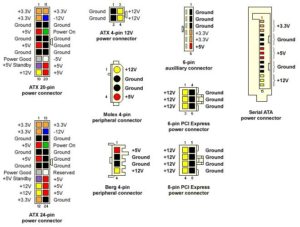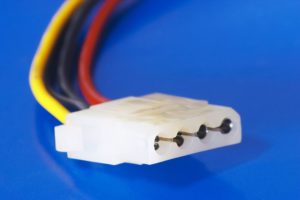- Published on
PC Power Supplies (Part 2)
- Authors
- Name
- Sam Mark
- @Twitter/smmk

In my last blog i wrote about some of the basics of computer power supplies you can read more here. I spoke about the wattage which is the most important specification when you are buying power supplies. But there are also a few more thing you should consider before you buy. Including cables and connectors, form factor, efficiency, and cooling. Many of these features often spawn more feature and industries like custom cabling, and silent power supplies. Power supply makers have become very innovative and creative in their markets.
Before 1995 many computer manufacturers used the AT standard. One of the main differences between the ATX is that the AT power supply included a power switch that was meant to mount to the front of the case. The ATX has momentary switch circuit built into the 20/24 pin motherboard connector which meant the case would plug its switch into the motherboard. The AT motherboard connection utilized a set of 12 wires separated into 2 plugs knowns as the AT P8 & P9 connectors.
Many users are familiar with the ATX power supply and it is by far the most popular. It was developed in 1995 by IBM. ATX motherboards are designed to work the 20/24 pin connector, and the ATX 4 pin 12 volt power connector. There are also variations of the ATX power supply the SFX and TFX is basically an ATX power supply in a smaller case. Many smaller form factor pcs will use these PSUs to save space. The EPS12V is very similar to the ATX except it has and 8 pin secondary connector for the motherboard. EPS12v are usually used from larger multi cpus motherboards, usually reserved for server use. Servers also utilize the ATX standard but many low profile server cases have smaller specialized power supplies. They also have redundant power supplies in a single case for extra reliability but that makes them very expensive.
In addition to the motherboard connectors PSUs also power all the peripheral hardware inside a computer, including optical drives, hard drives, and floppy drives. Since 1976 many of the 5.25 sized drives and the 3.5” hard drives have been connected to the power supply by the AMP Mate-N-Lock connector. Also known as the molex connector, but the molex connector company did not’ create the 4 pin connector that were use inside modern PCs. It just that Molex became common vernacular to refer to nylon encased pin type plugs. AMP Mate-N-Lok isn’t as snappy as molex so i will refer to them as molex as well. These plugs became ubiquitous in early computing even now power supplies might ship with a few connected. The molex plug’s popularity also caused a few issues including poorly manufactured pins to misalign when plugging and unplugging them. This caused jammed insecure connections, and bent and broken pins. Often poorly manufactured molex nylon housings were either a little to big or small which would cause the pins to become stuck or just slip off. The molex style (AMP Mate-N-Lok) connector has mostly been replaced by the new SATA style power connector.
This entry has gotten a bit long i will write more about the innovations and new feature that PSU maker have come up with in another article.


